The most critical piece of survival gear is arguably your survival knife.
While a dinky $20 knife made in China is better than nothing, the quality of your survival knife matters.
Those cheap knives will dull quickly. Their poor-quality metal will break when put to the test, potentially injuring you in the process.
However, there is no reason to spend a fortune on a survival knife.
Here is what you need to know to get a quality fixed blade on a budget.
Comparison Table
Best Cheap Survival Knives
Let’s dive in and have a look at the best survival knife for the money.
Morakniv Mora – Black Bushcraft Knife
Tang: Partial | Overall Length: 9.1″ | Blade Length: 4.3″ | Weight: 5.4oz | Blade Type: Fixed | Shape: Clip Point | Material: High Carbon Steel | Handle: Rubber | Made in: Sweden
The first thing that will draw you to the Morakniv Mora black bushcraft knife is its sleek design. It feels like a knife you’d use to take on the apocalypse after the fall.
This is a fantastic all-rounder at an excellent price point. It will tackle the tough jobs like batoning wood but is equally at home doing the delicate tasks around camp such as cleaning fish or game.
It comes with a built-in fire steel and sharpener, which are decent quality. I’ve got to admit that anytime a knife has built-in tools, I get suspicious. However, most of those survival knives put their tools in the knife handle, thus weakening it. The Morakniv built survival tools into the sheath to avoid this.
This knife is perfect for your wilderness trips and comes highly recommended.
Gerber LMF II Infantry Knife
Tang: 4/5 | Overall Length: 11″ | Blade Length: 5″ | Weight: 11.7oz | Blade Type: Fixed | Shape: Drop Point | Blade: 420 High Carbon Steel | Handle: Rubber | Made in: USA
This knife is solid, originally designed for American aircrew; it will happily cut through an aircraft fuselage!
This thing is beautifully balanced and just feels “right” in the hand. The rubberized handle provides superior grip, and it also has an incorporated handguard.
The LMF II is incredibly versatile, with a strong pommel that can be used as a hammer or glass breaker. It also comes with a high spec sheath and knife sharpener.
For a more detailed look at this knife, check out our full hands-on review – Gerber LMF II Review
KA-BAR Becker Campanion BK2
Tang: Full | Overall Length: 10.5″ | Blade Length: 5.25″ | Weight: 16oz | Blade Type: Fixed | Shape: Drop Point | Material: 1095 Cro-Van Carbon Steel | Handle: Grivory | Made in: USA
I understand why they named this knife the “Companion” – you want to take it everywhere. Even though it is large at 10.5 inches, it has enough weight that you don’t feel like you’ve got a blade flopping off of you.
True survivalists will appreciate the heavy-duty MOLLE-compatible sheath on the Becker BK2. It is a minimalist design to save weight and bulk, and you can quick-release your knife easily.
Yes – I know many people prefer leather sheaths, but you can’t beat the price.
Knives of Alaska Bush Camp
Tang: Full | Overall Length: 10.5″ | Blade Length: 6” | Weight: 8.5oz | Blade Type: Fixed | Shape: Drop Point | Material: D2 Steel | Handle: Rubberized Suregrip | Made in: USA
Knives of Alaska isn’t as well known as the other cheap knives reviewed here. However, the company should get your attention for the quality products they make in the USA. (Read more about our favorite US made survival knives)
There are a few features that set this knife apart from the others. First, the Suregrip knife is quite long, at 10.5 inches. However, it isn’t too heavy at 8.5oz. Those extra ounces matter when you are trekking or backpacking long distances.
Serious hunters will appreciate the non-glare matte finish of the camp knife. Its D2 steel is high-carbon and has a hardness of 59-61. Not bad for a cheap survival knife!
Ontario Knife Company RAT-3
Tang: Full | Overall Length: 9” | Blade Length: 3″ | Weight: 5.3oz | Blade Type: Fixed | Shape: Full Flat Taper | Material: 1095 Carbon Steel | Handle: Micarta | Made in: USA
This knife is almost always mentioned in discussions of the best survival knives. It practically has a cult following; people like it so much.
As for toughness, the RAT-3 can baton wood, slice meat, sharpen sticks, and perform survival tasks. It also has an edge that is easy to maintain, which is great considering how much you’ll use it.
Another great thing about the RAT-3 is its size. Neither too large nor small, it fits into almost anyone’s hands. At 5.3 ounces, it is light enough to take with you backpacking while still getting a reliable blade.
KA-BAR 1258 Short Fighting/Utility Knife
Tang: Full | Overall Length: 9.25″ | Blade Length: 5.25″ | Weight: 6.4oz | Blade Type: Fixed | Shape: Clip Point | Material: High Carbon Steel | Handle: Kraton | Made in: USA
This is the only clip-point that made it to our best cheap knives review.
In general, drop point blades are stronger and can perform more versatile survival tasks, such as skinning, carving, and batoning. However, clip points have their place too.
Clip points are better for detailed work. They also make better weapons (and this K-Bar knife would certainly intimidate an opponent!).
If you are more interested in a self-defense tool that can still perform some bushcraft tasks, then the K-Bar 1258 is the right choice.
Condor Bushlore Camp Knife
Tang: Full | Overall Length: 6 3/8″ | Blade Length: 3″ | Weight: 8oz | Blade Type: FixedShape: Drop Point | Material: High Carbon Steel | Handle: Hardwood | Made in: El Salvador
This camp knife might be small, but it is up for demanding tasks. The blade shape means that the tip holds up very well, and I found that the knife kept its edge well.
Condor added features that traditionalists will like, such as the 100% leather sheath and the hardwood handle. The only issue is that this knife might be too small for large hands.
Qualities of a Good Survival Knife
- Length
- Tang
- Blade shape
- Blade material
- Pommel
- Handle
Length
When you watch a Hollywood movie like Rambo, you will almost always see the characters running around with some gigantic knife. While these do look fearsome, a big knife isn’t always better.
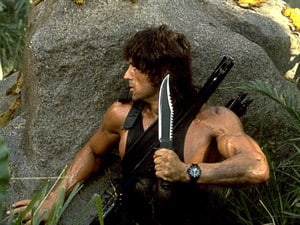
Large knives are cumbersome to carry (every ounce matters in your survival pack!). It could easily get snagged on something if you were to have one on your hip. If you were to put it in your pack, it wouldn’t be readily accessible.
Large knives are also terrible when doing precision tasks like carving snares or using the tip as an improvised screwdriver.
By contrast, small survival knives can’t do challenging tasks like batoning wood.
In a family survival situation, I might have one large knife for myself, a medium-sized knife for my wife, and give my daughter the tiny Swiss Army knife to carry. But, if you only have 1 survival knife to pick, I’d go for a medium-sized one.
The perfect survival knife length is between 9 and 11 inches. So, the blade might be 5 inches and the handle another 5 inches.
Tang
Tang is the part of the knife that extends into the handle. The tang is usually attached to the handle with bolts, pins, screws, or glue. Cheap knives will have just a small partial tang glued to the handle. If you used these knives for anything requiring force, the handle would easily break off.
When choosing a survival knife, you want to select one with a full tang. Because there is more metal, the knife is much sturdier.
Even if the handle comes off, you can still use it simply by wrapping some paracord around it.
The only real downsides are that full tang survival knives will cost more and that the full tang adds weight to the knife. If weight is a concern, you could get a skeletonized tang which is a full tang that has some metal removed from it to make it lighter.
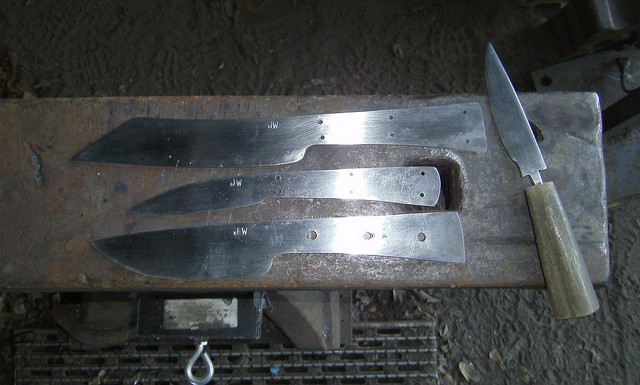
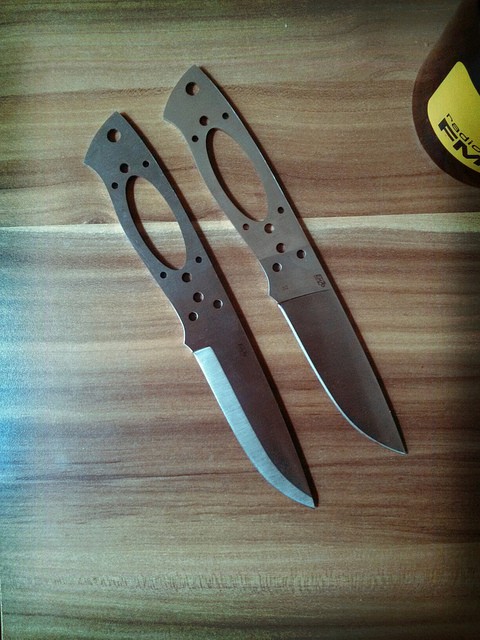
What about folding knives?
A folding knife, such as a Swiss Army knife, cannot be a full tang. For this reason, you should never choose a folding knife as your primary survival knife.
This doesn’t mean that folding knives don’t have their place and advantages, and we look at the best assisted opening knives in this post.
Blade Shape
The shape of the knife blade is also known as its grind. There are all sorts of knife grinds, and some are much more suited for specific uses.
For example, a kitchen knife has a rounded blade shape, perfect for cutting onions and carrots. Though, this knife won’t help you spear a fish or carve an arrow!
AVOID: Knife blades sharp on both sides (like a dagger). While these might be good for fighting, they are terrible for more survival uses and can even be dangerous. For example, I often rest the back of the knife on my thumb for leverage when doing precision work like carving. This is not safe with a double-edge blade.
AVOID: Knife blades with angles, hooks, or highly rounded edges. These blades won’t hold up well during rugged tasks. You also want to avoid knives that have completely flat blades. There needs to be a bit of curve to the blade to reduce strain on the hands when cutting with it and distribute the force throughout the blade.
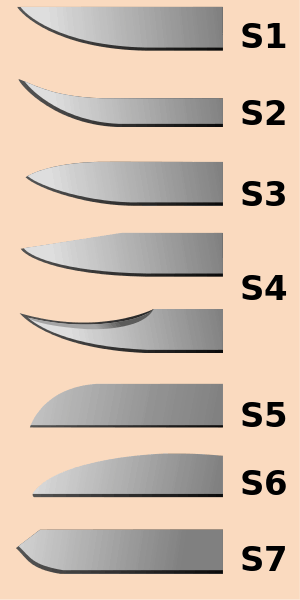
The BEST survival knife blade shape is a drop point blade (S3 in the picture). Starting at about halfway down the blade, the dull side of this blade slopes downward slightly to meet the point. This geometry is best suited for most survival tasks.
Alternatively, the clip point blade (S4) is also suitable for survival situations. It is like a typical blade (S1) but has a “clip” taken out. The sharper tip makes it better suited for cutting in tight places and also using as a pick. The clip is often curved. Don’t choose a clip-point blade with too much curve because it could easily break if you pound on it.
Read more about the various types of survival knives available.
Blade Material
Survival knife blades are made from steel, an alloy of iron and carbon. There are two main types of steel used to make survival knives:
- Stainless Steel: Isn’t as strong as carbon but resists rust better. It loses its edge faster and is harder to sharpen than carbon steel.
- Carbon Steel: These blades are more robust and hold an edge longer but will rust if not cared for properly.
Remember that not all stainless steel and carbon steels are the same! How the materials are made will affect how durable and strong they are.
Here are some great charts via BladeHQ, which show the range of knife steels and the trade-offs that need to be made between hardness, corrosion resistance, edge retention, and ease of sharpening.
Related Posts
- See here for more on knife sharpeners
- See here for more on knife oil
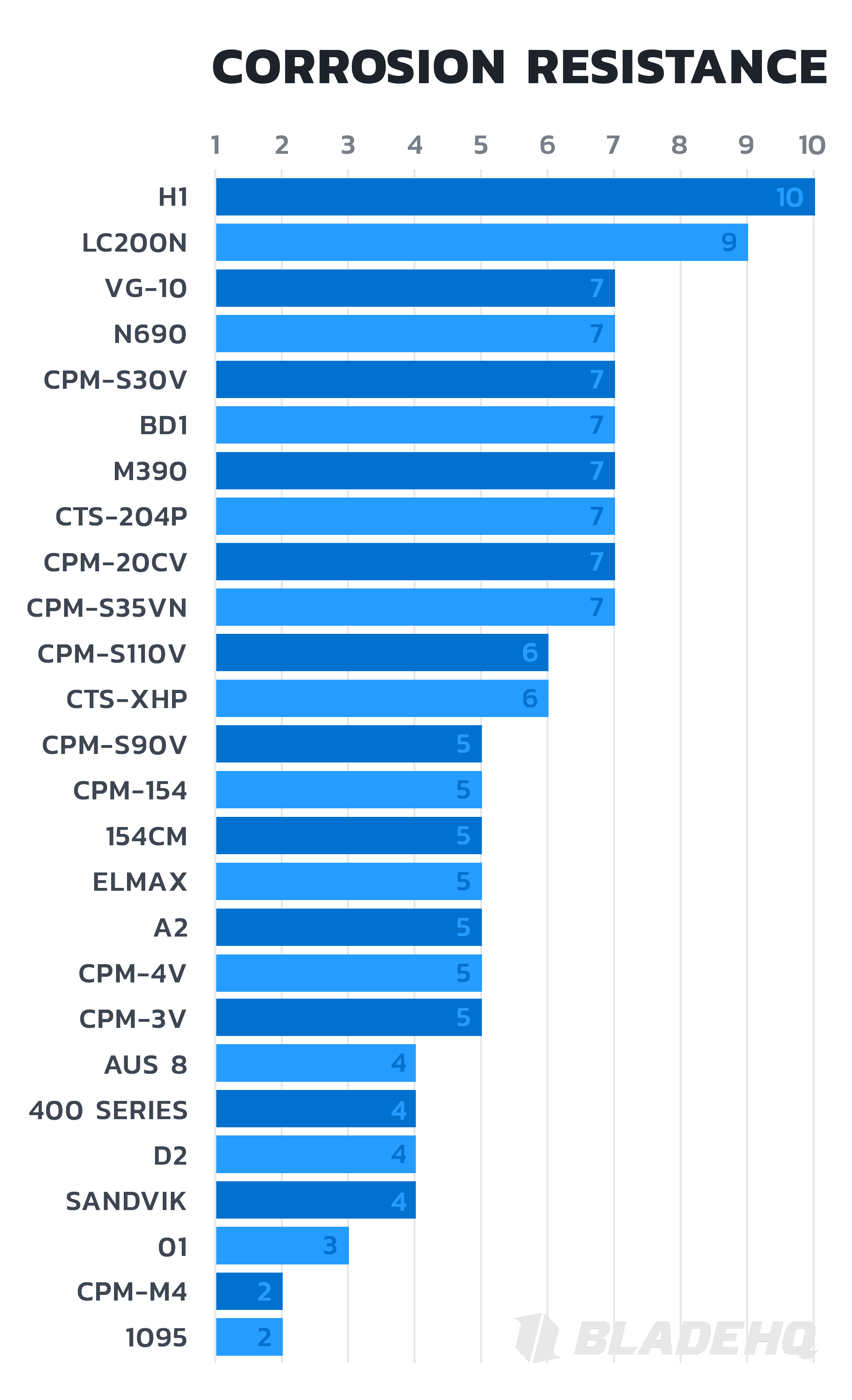
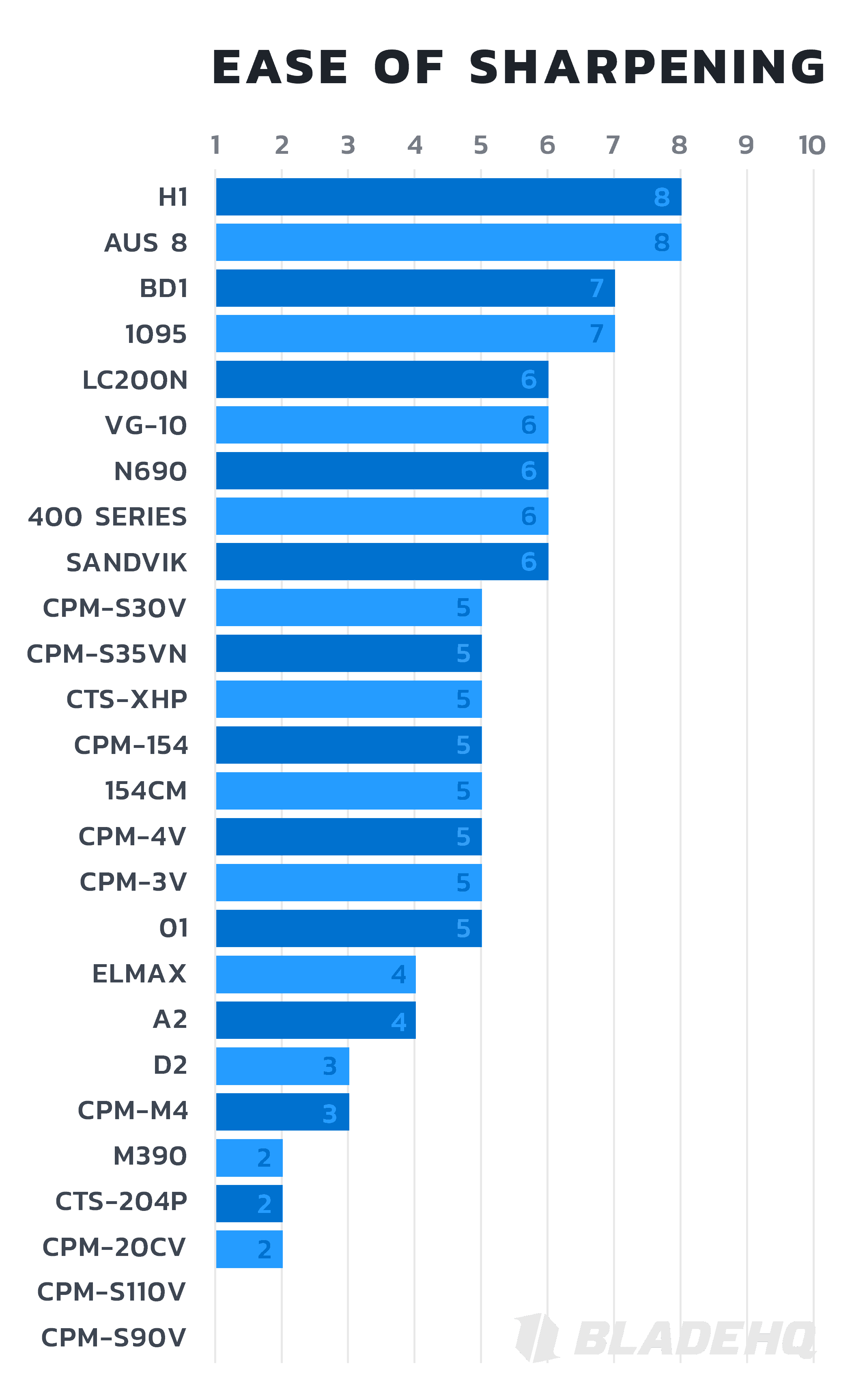
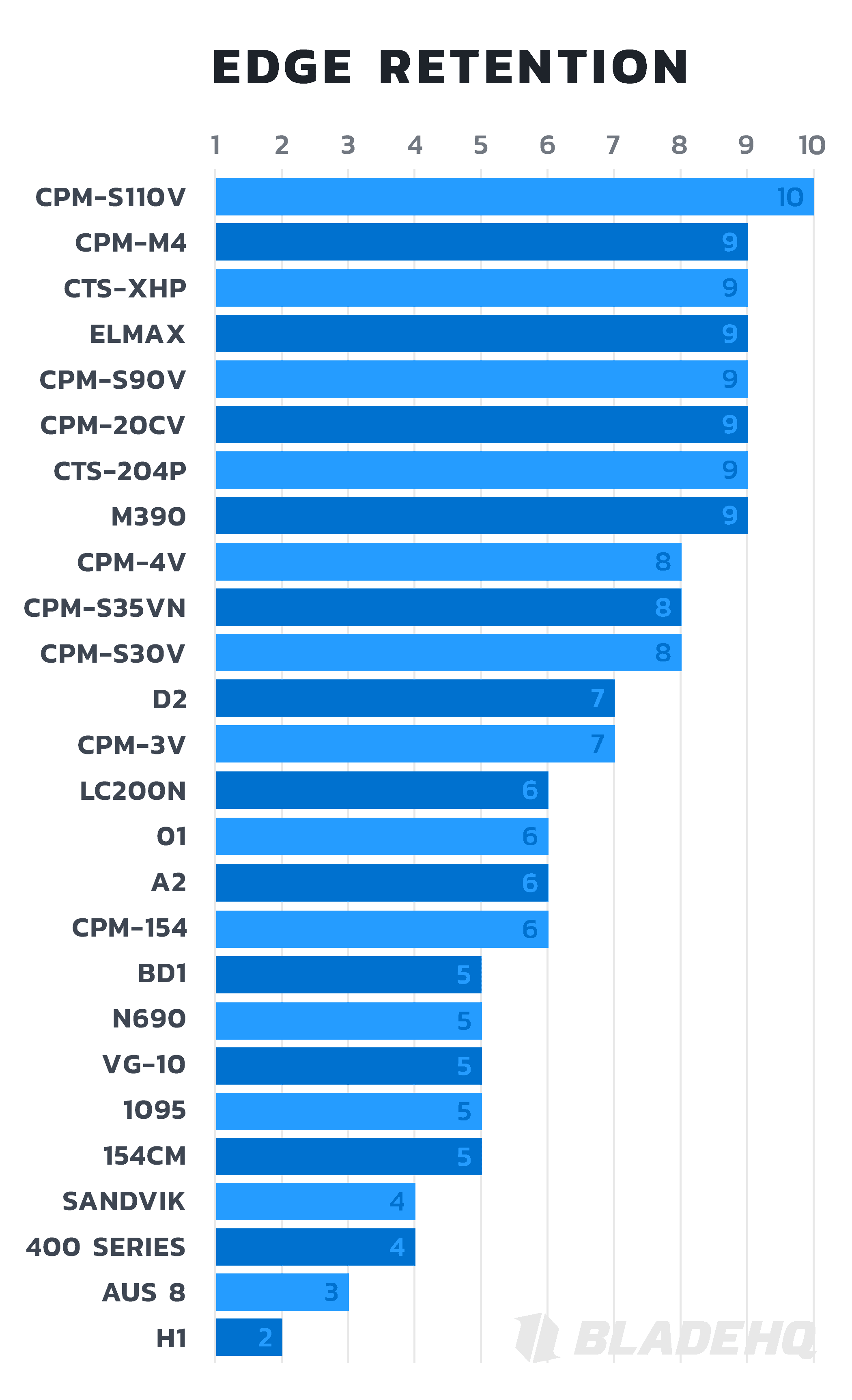
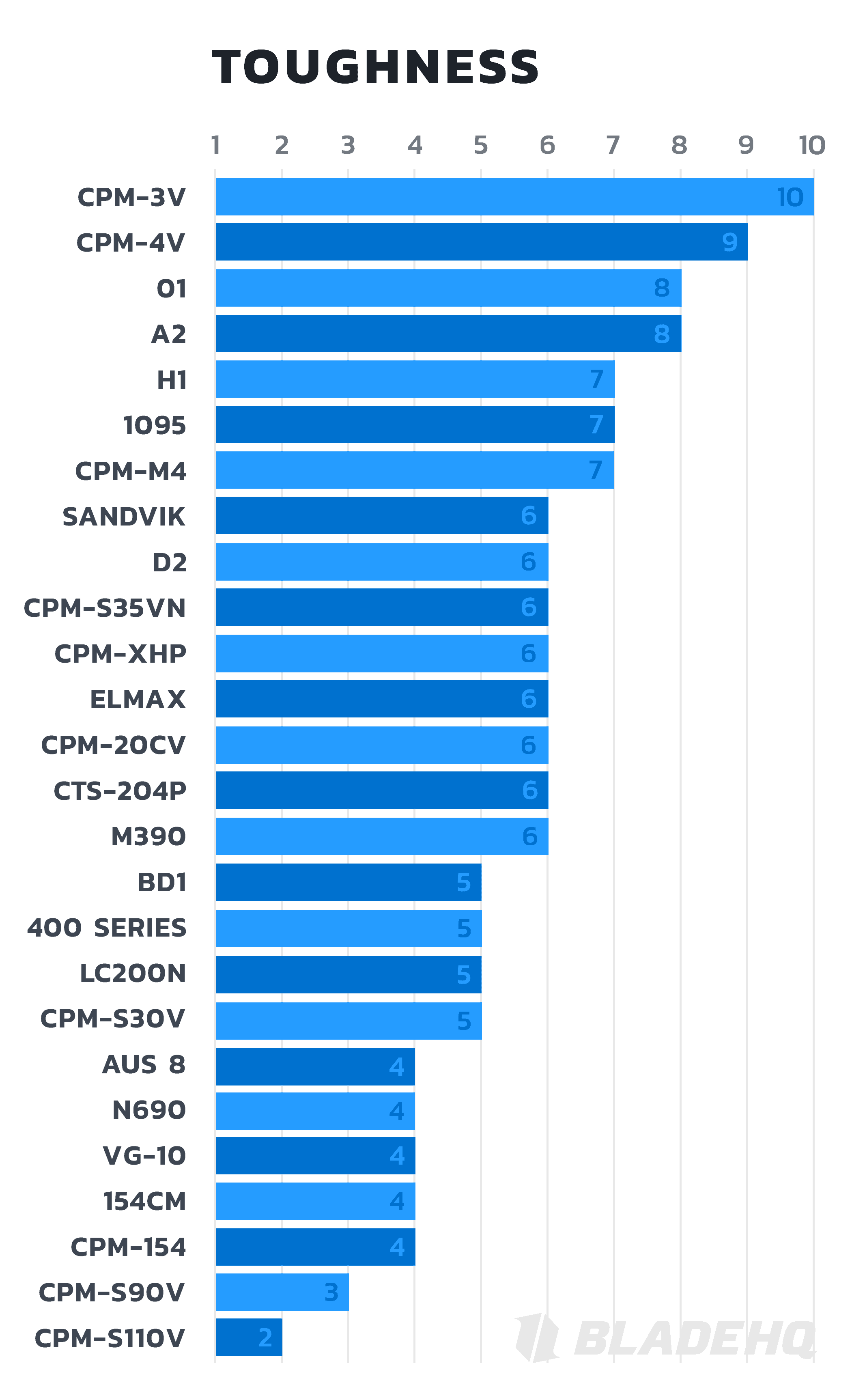
Pommel
The bottom of the knife’s handle is the pommel, more frequently just called the “butt” of the knife. It might not seem like an essential characteristic of your survival knife, but you want to make sure you choose a flat pommel.
Do NOT get a pommel that is curved or V-shaped. The reason is that you may want to hit the butt of your knife with a rock or piece of wood (for example, if you are digging with your knife). Or, you might want to use the butt of your knife to hit something (such as when hammering tent stakes into the ground). You can’t do this safely unless the pommel is flat.
Handle
There is no one “best” handle material for a survival knife. I like wooden handles, but they need to be cared for and absorb water.
Rubberized handles have a very comfortable nonslip grip, but they don’t last as long.
There are many comfortable, long-lasting synthetic materials for the handle. I recommend handling several survival knives and seeing which material you like best.
Some knife handles have guards on them. I personally don’t like them because they make it difficult to do carving. But, some might prefer to have them there.
Most importantly, do NOT get a knife handle with a hollow compartment (such as for holding matches) or a built-in compass. These features may seem helpful, but they are just gimmicks.
If your handle is hollow, it won’t be sturdy enough for real survival applications. And that built-in compass is going to break the first time you try to hammer with your survival knife.
What to Look for in a Cheap Survival Knife
With all that said, if your budget only allows you to buy one survival knife right now, then you want to make sure that it is a very versatile knife.
A machete is NOT a versatile knife!
Nor are any of those other big, intimidating Rambo knives you see on bad TV shows.
To sum up, the most versatile survival knives will have the following attributes:
- Fixed Blade
- Full Tang
- Blade Shape: Drop point or clip point.
- High Carbon
- Medium Size: Bigger is NOT better! The blade part of a versatile survival knife should be between 4 to 7 inches. Any larger than this, and your survival knife will probably be challenging to use for detailed tasks.
- Blade Thickness: I find that the perfect blade thickness falls between 0.17 to 0.25 inches.
- Non-Gimmicky Handle: With a flat pommel (the back end of the handle) to be used for hammering.
- Grind: A flat grind is best because it can be sharpened easily and has many versatile uses, such as splitting wood and chopping.
Note that you probably aren’t going to find all of these features in a cheap survival knife. After all, it takes a lot of resources to produce a good quality knife. Just buy the best quality survival knife that you can afford.
Survival Knife Uses
Aside from the obvious uses of a survival knife like self-defense, there are countless ways you can use it for your survival:
- Batoning wood
- Making cordage
- Digging holes
- Skinning animals
- Making a survival shelter
- Cutting improvised bandages for first aid
- Making bushcraft tools
Tips for Buying Survival Knives on a Budget
Firstly, resist the urge to buy a bunch of cheap survival knives just because they look cool. Having five 20-dollar knives will not do you any good when they all break or become dull after a few cuts.
Spend your money to buy ONE excellent survival knife!
A good survival knife will last throughout the years.
What was your first survival knife? What do you use now?
“Carving Project – Cooking Crane” (CC BY-NC-ND 2.0) by teejaybeeForged Blades by Johnny; Found on Flickr; CC BY NC 2.0
enzo trapper blades by Michael Pollak; Found on Flickr; CC BY 2.0
Knife blades S Series; Found on Wikipedia; CC BY 3.0
My Companion in the Canyon by Adam Meek; found on Flickr; CC BY 2.0
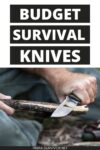
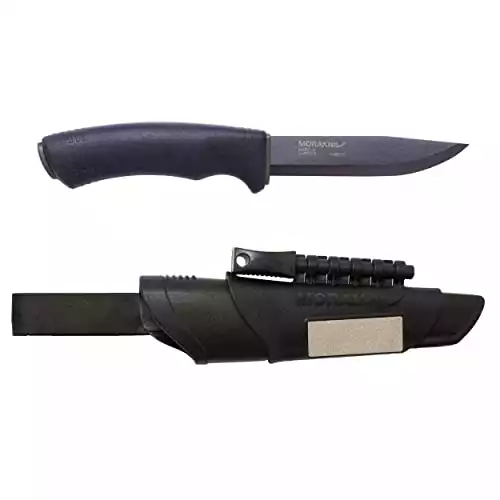
![GERBER LMF II Survival Knife, Black [22-01629]](https://www.primalsurvivor.net/wp-content/uploads/2023/03/41mFzgekZ1L._SL500_.webp)
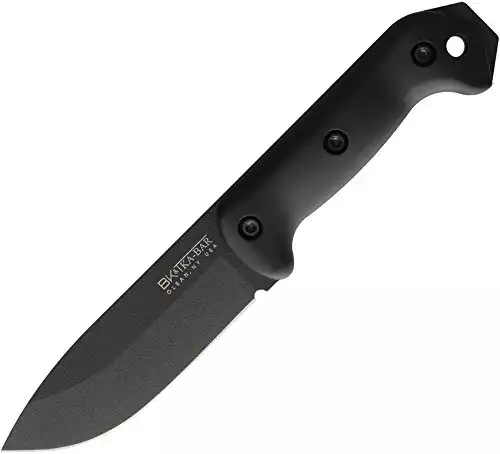
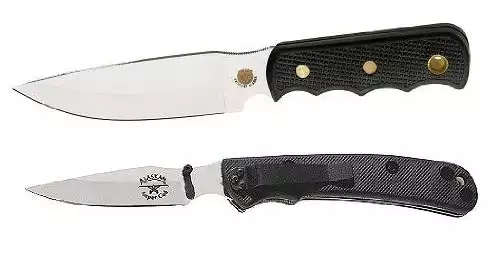
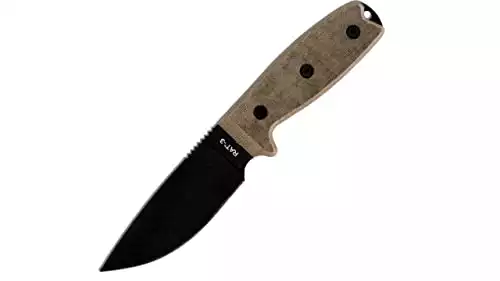
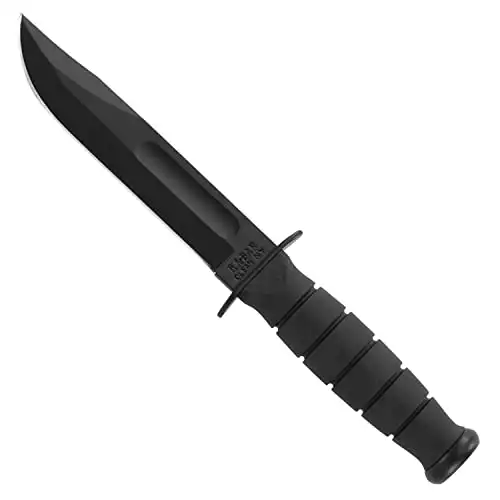
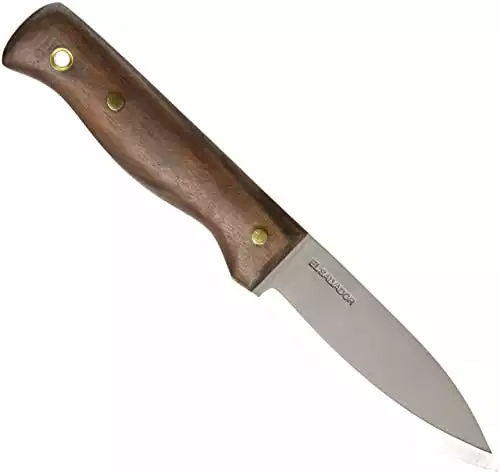

![GERBER LMF II Survival Knife, Black [22-01629]](https://m.media-amazon.com/images/I/41mFzgekZ1L._AC_SX466_.jpg)







I’ve been carrying a full tang knife in the field since the ’80s when there were a lot fewer foreign choices and most were traditional styles like the Buck. Since then a number of things have come up that have improved a field knife – some returning to their older roots.
While the Kabar/Camillus was the issue knife from WWII on, it was based on an older style – the Marbles camp knife. There was a variety of lengths and points, the more noted one was a centered point with a groove in the blade – which was there only to reduce the amount of material used, no other reason. It was “value engineering” to reduce costs on blade forging. As time went by dozens copied it, and like anything traditional the reason for the shape was lost in simply looking like what was traditionally revered. That pattern of business dates to the 1840’s when Sheffield copied what they understood was the “Bowie knife” – which few had actually seen – and then imported dozens of variations on that with all sorts of engraving and pictures which sold to even more “sportsmen” who lived in more suburban surroundings than the pioneers.
A habit in our culture that has been really hard to break.
Rather than list Brands and Models, it’s often better to list specifications and features, then chose what fits the user best. Blade – 4-5″ max. This knives are used to cut, and the largest task they are used for is food prep, not downing trees. Pioneers who needed that job done had tomahawks and hatchets for cutting and splitting smaller limbs and firewood, larger axes for cutting trees, and a pack animal to haul it because anything less was really roughing it. Very few actually walked in the wilderness to establish a new home with only the possibles in their bag – they were largely Northern European immigrants with a long history of living in tough wooded terrain and knew how harsh winters could be.
Metals these days run the gamut of alloys, keep in mind the harder it is to abrade the blade and retain the edge, the harder it is to abrade the blade and sharpen it. They are simply too sides of the same coin – high abrasion resistance is high sharpening resistance. Don’t go too far, and keep in mind that the long held standard for outdoor blades is simple carbon steel with 60-80 points of carbon – 1080 or 1095 carbon steel is very common. That grade is easy to get really sharp, easy to resharpen, and also won’t cost more than a days pay in today’s society – another cultural baseline. When a knife approaches a weeks pay – its the same as a watch, more social status than function is being bought.
A flat grind is best for all purpose use, those “survival” grinds which barely come off a thick edge aren’t as good as a long taper with thinner edge. A knife fgood at dressing out a deer, slicing a rabbit, or notching trap triggers isn’t real good at beating on it with a rock to split wood – it’s the wrong tool, and in terms of survival, risking the only tool you may have for long weeks of difficult times trying to return to more populated areas. Again – pioneers left with pioneering tools, not just one belt knife.
Grip should be as simple and smooth as possible, possibly a minimal cross guard but so small you can still choke up in the blade to control the tip with a finger. the butt with a pronounced finger stop, which can also be pinched in the fingers of one hand to lightly chop with. Anything bigger, chop with a bigger tool. While some have screws to hold the grip on, with a storage space underneath, it’s better to stake them in place so they never disappear while hiking. It’s amazing the number of things that go missing and using a knife with no grips is one of the more difficult things to discover. Having a hole or tube thru the butt allows for a thong, which can be worn around the wrist when occupied in difficult circumstances and the loss of a knife a significant problem.
If the back of the blade is square edged it’s a bit rough on the thumb when used for pressure, but it also scrapes sparks more easily on a flint or ferro rod to make a fire. While it was a first line firemaker in it’s day, it’s a tool of last resort now – bring a primary firemaker with a redundant second source when in the wilderness.
The sheath is more important than most makers want to admit, it’s largely economized too much. Kydex or molded polymer is preferred now, not stapled or riveted leathers, which hold water against the blade causing long term corrosion, along with raw contaminants from food processing. A secure fit with redundant strap is preferred, and if a pouch with your firemaking tools is attached, with the knife secured to you, then worst case, you have it when you crawl out down river from the falls when you escaped that tribe of natives.
And if you lose it, you also haven’t lost a significantly expensive knife and one reasonably replaceable. The following wouldn’t hurt: ESEE, Rat, Kabar, Condor, Ontario, along with original makers of the British and German service knives.
Things to avoid? Stainless, military styles resembling a bayonet, and those cheap grinds with barely the edge sharpened.
No one knife does it for me when it comes to survival. We all know the saying: two is one and one is none. A survival knife to me has to do multiple tasks including: defense, carving, splitting (batoning), chopping and hammering. For defense, I prefer the Gerber Silver Trident. Maybe not the best of survival knives or combat knives, but it is large and intimidating and fits my large hands. For carving I use the Terävä Jääkäripuukko 110. It has become my go-to, all around camping and survival knife. For chopping I use the Terävä Skrama 240. This thing is like a gladius, machete and hatchet all in one. It is great chopper and I have used it for planing and carving. You can baton the hell out of it and it will hold up to just about anything you can demand from it.
Another one to add to the list is the Condor Primitive Camp Knife, which you can get below MSRP from websites such as knives depot or knife center.
For DIYers, the Lauri company makes some great leuku blades that I can say are tough with wear resistant edges. I had both the leuku 145 and 210 with leather washer grips, and they both survived every task I put them to. Yes, even batonning a six inch tree in half with the 145. Sadly though I lost them in a house fire. The 145 costs $17.75 from Ragweed Forge, and the 210 costs $28.75. I did also get the bolster plates, but that was only an extra $11 for both. Now Ragweed Forge also offers packs of four leather washers at $1.50. It looks like they’re made from 4-6 oz stock. They only charge $6 for shipping on all orders.
Oh, and sorry but the KaBar is NOT a full tang knife, so I have no idea why it’s even in this list. The steel may extend through the length of the grip, but that’s irrelevant. Because it’s encased by the grip material, it’s classified as a hidden, stick, or rattail tang. The tang width is less than half the blade width, and is thus prone to snapping at the blade/tang junction, which makes it inadvisable as a “survival” knife anyway.
I love my Tops/Buck short Nighthawk. Has proven itself many times as a good workhorse.
Just my humble opinion but if I could only take one of my many knives (my poor patient wife). I think it would by my kabar mk1w/ the kraton handle and kydex sheath. The leather spacer grip and sheath may look nicer to some but living in SWFL te humidity is a concern to me with rot and mildew. Just found the website and am looking forward to spending time exploring it.
Love my Grohmann knives have 2 great quality .
Do you think a serrated blade of a knife can saw through wood.
Yes a serrated blade will be better at cutting through wood than a straight edge. You could also consider a folding saw for this purpose.
Great selection! My favorite is the Gerber LMF II. My only drawback is that it is sometimes difficult to remove it from the sheath, using one hand. My third LMF is able to do this very smoothly. Overall it is an excellent field knife. My current field knife is the the Daniel Winkler Utility knife.
Yeah we love that knife here. Read a full review of the LMF II.
Any converstion about a budget survival knife has to include the Cold Steel G.I. Tanto, you can’t beat it, or rather, you can beat it, but you can’t break it. . Don’t believe me? Look at how it is abused on youtube. Everyone who has tried to kill it, has come away praising it…
first two bucks.. that hole in the metal at a weak point makes them complete crap in my opinion.
why bother with anything that could easily break, then your SOL
I have the lmfII, like it a lot but it is heavy.
So late to this party, but I have a question. You mentioned that carrying the Mora with a 9.1″ length felt like carrying a saber. 9.1 is close to the median overall length for all of the knives listed. What did you find particularly saber-esque about the Mora compared to the 11″ of the LMF or any of the other, longer knives?
Thanks,
Dd.
Whilst the blade is similar in length to the other knives, we found it less “balanced” in the hand hence the comment. Many people however love this knife and a lot of this comes down to personal choice and opinion.
Hey guys, I quite agree that a quality knife is an essential. But I want to share this story. I taught survival for many many years, to both military and civilians. I onetime had this young guy show up with one of those fake switchblade style stilettos. When I started explaining why his knife was not an appropriate “survival” knife he asked me; “Well, what do you think makes the perfect survival knife”? And just as I was getting to respond, with my years of “expertise” in the field, I had an epiphany. I told him, “The most perfect survival knife in the world is…..the one you have with you when it goes down.” And from that moment I still believe a quality knife is the best way to go, but really, ANYTHING with a well maintained edge is better than nothing.
Wise words DK. but we love our gear here and can’t resist a good survival knife!
You are absolutely correct.
Nice article, good choices except you should have mentioned some of the Schrade knives that have been huge hits such as the SCHF9 in 1095 carbon steel, the SCHF10 in 8Cr13Mov with micarta handles, the SCHF55 (smaller version of the SCHF42D), of course the SCHF42D and SCHF42 or even the compact SCHF14 which is made of 9CR18Mov steel.
And also, while sort of new to the eyes and ears of many buyers, Steel Will has some nice blades. And Cold Steel’s SRK and Recon Tanto have been and still are very popular.
I would suggest to new buyers they look at the Gerber Prodigy or Strongarm for those who like the LMF II, but can’t or possibly feel, they should not spend the extra dollars.
Hey Frank – thanks for the comment. Some interesting options there for alternatives to our choices.
Hey another great article. I was under the impression that the mora showed above was full tang… ?? I do own several other mora’s that I put through the ringer, batoning and what nots, the 711 and the companion, and they are not full tang and have not given up on me yet! At 15 bucks around there abouts each for those, they sure have served me well. The mora pictured above I found for just under 50 dollars with the fire stick included. Thanks again, love the web site…
Hey Wanderer, they are not full tang, probably best described as 2/3 tang. As you say though it is a very well built and affordable knife and can stand up to lots of abuse!
Thanks, that was very informative. I personally like Case XX knives. I wonder how you like them. I don’t see many folks toting one. They have always been a tough knife
Not tried those knives – will look out for one. Thanks for the rec.
No mention of kukri style knives? I am hearing a lot of good things about them though admit to not yet having tried one myself.
We have a post about machete’s here (Kukri included)
With max utility & under $100 in mind, check out Grohmann Knives made in Canada. They have “seconds” on offer at 1/2 price (Canadian, yet!) so you can get a really excellent knife for well under $100 US even with shipping charges. The Russell line are generally better designed, balanced and user-friendly than most off-shelf knives.
I have a fixed blade rubber handled SOG and well forgot the model name. Its one of their basic knives off the shelf however can t seem to mess this thing up. I’ve put it through hell.. . Just figured I’d make mention
Oh it was 83 dollars as well
Yeah SOGS are a solid choice.
Nice selection. I have the Condor Bushcraft with micarta handles, really nice. Some others to consider that I have:
Schrade SCHF 51 & 52. Both are good but I prefer the 51 unless I had only one knife and expected to baton a lot of wood.
Schrade SCHF 42D. A nice knife, feels good in the hand. The handle is a little on the smooth side.
Schrade SCHF 9. Beefy blade with a belly if you like that. The handle is thicker than the 51/52
Some others to consider (one of these will be the next one in my collection):
Buck 0119
Gerber Prodigy, Strongarm or LMFII
Nice collection! Thanks for the reviews.
Another choice to consider is the muela brand of knives. I found the survival 14 was a good one. Serrated spine and metal pommel for multiple uses.
Hi Alex, I haven’t used a Muela knife personally but thanks for the heads up. Will check them out.